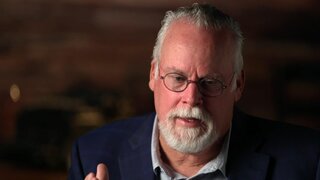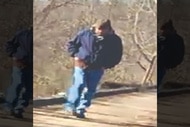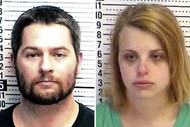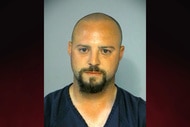Killer Roommates Behind UCLA Student's Grisly Murder That Initially Appeared to be Tied to Occult Ritual
Ron Baker, a 21-year-old college junior with an interest in mysticism, was found with his throat slashed in the notoriously nicknamed "Manson Tunnel."
In the early morning hours of June 22, 1990, hikers stumbled upon a body in a railroad tunnel in Chatsworth, a suburb of Los Angeles.
“The Chatsworth Tunnel once was called the Manson Tunnel because the Manson gang hung there,” investigative journalist Pat LaLama told The Real Murders of Los Angeles, airing Fridays at 9/8c on Oxygen.
Police rushed to the tunnel, which was marked with occult symbols. The victim had been “brutally beaten. He had multiple stab wounds,” said Greg Kading, a retired Los Angeles Police Department detective. The victim’s throat was slashed.
The medical examiner determined the victim’s blood type was A. He had the rare blood type AB positive under his nails, and he'd been killed on June 21.
Victim identified as UCLA student Ron Baker
The victim was identified through a missing-persons report as 21-year-old Ronald "Ron" Baker, a junior at UCLA studying astrophysics. He had been reported missing on June 22.
Baker, who was wearing a cross and a pentagram when he was found, was involved in Amnesty International and interested in mysticism, according to his sister, Patty Baker Elliott.
Baker’s parents told police that on June 21, an anonymous phone caller demanded $100,000 by 5 p.m. the next day for the safe return of their son.
The Bakers called their son’s roommates, Duncan Martinez and Nathaniel "Nathan" Blalock, who shared an apartment with him in Van Nuys. They said he’d gone to visit friends at UCLA.
Baker’s parents thought the ransom demand was a prank. But when they got another call on June 22, they grew concerned and reached out to police to file a missing persons report.
Investigators interviewed Baker’s roommates. While Blalock was out of town, Martinez claimed that the last time he saw Baker was when they dropped him off at the bus station to go to UCLA.

Why did investigators look at whether Ron Baker's murder was linked to the occult?
Martinez told detectives that Baker was going to attend a meeting with a group of friends called the Mystic Circle, according to Kading. When detectives searched Baker’s bedroom, said Kading, they found “a makeshift altar” with knives, candles and a pentagram. Police couldn’t rule out that the murder was linked to occult practices, according to LaLama.
Knives from the homemade altar were analyzed and found to have no link to the murder. At the same time, police noted that the murder occurred around the date of the summer solstice, an important date in mysticism.
Patrick Metoyer, a retired LAPD detective, told The Real Murders of Los Angeles that he helped explain the pentagram symbol. He shared that it represented protection from evil and that it had a benevolent side.
RELATED: "High Priest of Silent Cinema" Killed in Business Partner's Murder-For-Hire Plot
On June 28, a memorial for Baker was held. Martinez gave an emotional address. Detectives spoke with some of Baker's Mystic Circle friends who attended. They learned that a meeting wasn’t slated for June 21.
Investigators circled back to Martinez and Blalock, who was home this time. He repeated what Martinez had told them about dropping Baker at the bus station. Afterwards, they played basketball and went to a party, he said.
Martinez then revealed that after Baker’s parents called on June 22 in search of their son, he went to Chatsworth Park to look for him. The spot where Baker’s body was found hadn’t been made public, so the comment raised a red flag.
“If the park was not a place that Ron frequented, they wouldn't know to go look there unless they had information about the murder,” Kading said.

Duncan Martinez and Nathan Blalock Raise Red Flags
Martinez said that Baker regularly went there to meditate, according to the investigator. Baker’s family couldn’t confirm or refute that claim, so detectives asked Martinez to take a polygraph test. He agreed, and he flunked it.
He lawyered up and refused to take it a second time. Detectives considered Martinez a person of interest. But the family supported Martinez, who’d moved into a new apartment after the murder. They let him use their garage to store his belongings.
When detectives tried to locate Martinez to speak with him, they couldn’t track him down. The Bakers looked for clues to his whereabouts in the stored boxes.
Baker’s father was alarmed by a list in a box. The first item was to get a new ID, said Baker Elliott. The second one was to sell his car.
On July 24, 1990, a friend of Martinez contacted police to report that he had been abducted, according to investigators.
RELATED: Real Housewife Garcelle Beauvais to Narrate The Real Murders of Los Angeles This Fall
She told police that Martinez called her and he said he was being held captive in an L.A. warehouse. The call was recorded on her answering machine.
Detectives interviewed her and analyzed the call. They determined it was made from a pay phone at an airport in Las Vegas.
Martinez was in the wind, until 18 months after the June 1990 killing. On December 12, 1991, detectives were contacted by a Salt Lake City, Utah attorney. His client, Martinez, wanted to come forward with information about the murder of Baker.
Martinez had been arrested for traveling under a false identity, a federal offense. He was seeking to use what he knew to get himself out of the arrest, according to The Real Murders of Los Angeles.
On December 13, L.A. detectives flew to Salt Lake City. Before being interviewed, Martinez was given a “King for a Day” immunity deal.
It allowed him to divulge incriminating information without the fear of having that information used against him in a criminal prosecution.
The deal comes with a string attached. Martinez could never talk about the case with anyone at any time.
Martinez admitted that he and Blalock conspired to kidnap Baker and demanded $100,000.
On June 21, the three men drove to Chatsworth ostensibly to celebrate the summer solstice. Martinez said that that's when they walked into the tunnel, Blalock tripped on the tracks and Baker made fun of him.
“They got into a tussle and Nathan snapped,” said Kading. That’s when he stabbed Baker. “Duncan explains that the only reason he went along with it is because he was in fear of Nathan,” Kading added.
The knife used to kill Baker was tossed, along with their clothing. Then they went to the party.
The false identity charges against Martinez were dropped. Before he walked away, he gave a blood sample. It came back type A.
Back in L.A., investigators found Blalock behind bars for a bank robbery. They got a court order for a blood sample. Blalock’s blood type was AB positive, a match for blood under Baker’s fingernails.
Ron Baker's Brutal Murder Solved
Martinez agreed to work with police. He wore a wire and visited the incarcerated Blalock, who eventually mentions his role in the slaying. Blalock was arrested for Baker’s murder.
Martinez was free to go. But in 1993, following his arrest for burglary in Utah, L.A. detectives discovered that Martinez had discussed Baker’s murder, nullifying the “King for a Day” deal.
L.A. investigators had Utah police secretly record their conversation with Martinez, who revealed that he was involved in Baker’s homicide.
“Duncan says to Nathan, ‘Make sure he's dead,’” said Kading of what Martinez recounted in the recorded interview. “At that point in time, Nathan slices Ron's throat and leaves him for dead.”
In 1996, Martinez and Blalock were tried separately. Each was convicted and sentenced to life without the chance of parole.
In June 2020, Martinez’s sentence was commuted by California Gov. Gavin Newsom, NBC Los Angeles reported. Ten months later, he was released from prison.
Blalock continues to serve a life sentence.
To learn more about the case, watch The Real Murders of Los Angeles, airing Fridays at 9/8c on Oxygen.


















































